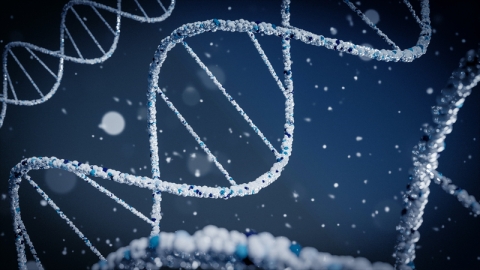

Scientists have developed an innovative method to customise and strengthen DNA origami structures, which could lead to advances in medicine, biotechnology, and beyond.
9 May 2024
6
A new technique in building DNA structures at a microscopic level has the potential to advance drug delivery and disease diagnosis, a study suggests.
A team of scientists, from the universities of Portsmouth and Leicester in the UK, has developed an innovative way to customise and strengthen DNA origami.
DNA origami is the method of creating nanostructures with remarkable precision using DNA strands as building blocks. However, these structures are delicate and can fall apart easily under biological conditions, like changes in temperature or exposure to certain enzymes found in living organisms.
In a new paper, published in the Journal of the American Chemical Society, researchers have presented a unique way to make the origami structures stronger and more versatile in a one-pot reaction, via a process known as triplex-directed photo-cross-linking.
By strategically modifying DNA strands during the design process, they were able to introduce additional nucleotide sequences – which are the basic building blocks of DNA - that serve as attachment points for functional molecules.
Attachment of the molecules was achieved by using triplex-forming oligonucleotides carrying a cross-linking agent. They then used a chemical process involving UVA light to permanently link these molecules to the DNA shapes.
A particular benefit of this approach is the generation of “super-staples” that act to weave the structure together. The paper says cross-linking to regions outside of the origami core dramatically reduces the structure’s sensitivity to heat and disassembly by enzymes.
We envision a future where DNA origami structures could be used to deliver drugs or DNA directly to diseased cells, or to create highly sensitive diagnostic tools.
Dr David Rusling, University of Portsmouth’s School of Pharmacy and Biomedical Sciences
Lead author, Dr David Rusling from the University of Portsmouth’s School of Pharmacy and Biomedical Sciences, said: "The potential applications of this technique are far-reaching. The ability to tailor DNA origami structures with specific functionalities holds immense promise for advancing medical treatments and diagnostics.
"We envision a future where DNA origami structures could be used to deliver drugs or DNA directly to diseased cells, or to create highly sensitive diagnostic tools.”
Current applications of DNA origami in biomedicine include vaccines, biological nanosensors, drug delivery, structural biology, and delivery vehicles for genetic materials.
Co-author Dr Andrey Revyakin, formerly from the University of Leicester, said: “My lab has struggled for years to make DNA origami structures that remain functional in real-life biological applications. Dr Rusling’s triplex-based method, which “upgrades” the classical DNA double-helix with an additional, third strand, stabilizes the DNA shapes, and does so with great precision, without affecting the functional modules of the molecule.”
The paper says the new strategy is scalable and cost-effective, as it works with existing origami structures, does not require scaffold redesign, and can be achieved with just one DNA strand.
Dr Rusling added: “What is really exciting about this technique is that it did not change the underlying origami DNA sequence, offering the ability to use these structures as carriers for synthetic genes.”
More like this...
Scientist wins international award for her work on developing cancer diagnosis technologies
11 April 2024
3 minutes

Pollen is a promising sustainable tool in the bone regeneration process
3 April 2024
7

Portsmouth researcher awarded share of £6.6m funding to help develop new drug
20 March 2024
6

